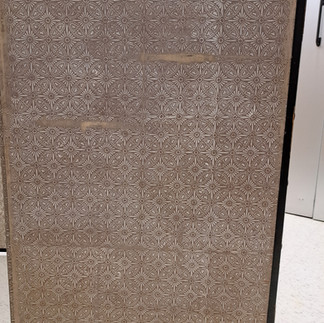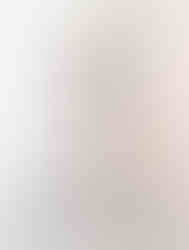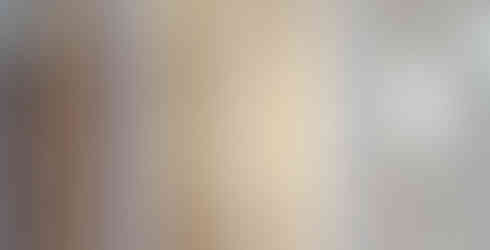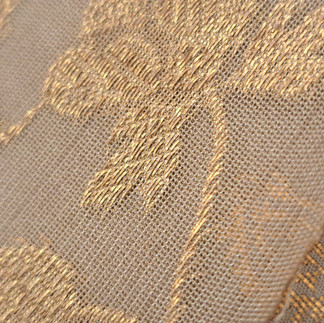Textile Treatment and Research Notes of a Japanese Folding Screen
- Fenna Engelke
- Jul 18, 2022
- 7 min read
Updated: Dec 21, 2022
As part of my summer internship at the National Museum of Asian Art I was able to work on the textile of a folding screen that was being given remedial treatment before an exhibition. Since it was not a full treatment, I felt that describing the treatment would work better as a blog post which would also allow me to talk about my notes on textiles. Since my background is in paper and book conservation, I had to do some of my own research to better understand the object and the goals of the treatment.
In the following blog I will cover:
Introduction to the folding screen I treated at the NMAA
Some information about the structure of folding screens in general
Notes focusing on golden brocade fabrics found in Japanese mountings
The treatment of the textiles along the edges of the folding screen
Introduction of the object
Images: (1) An Eagle on A Snow-Laden Blossoming Plum Tree, image from the NMAA's object catalogue (2) Showing the folding screen with the panels numbered to assist with the description of the object. These numbers are arbitrary and only there to assist with description.
The screen is called An Eagle on A Snow-Laden Blossoming Plum Tree, a six-panel folding screen from the Momoyama period, painted by Soga Nichokuan (曽我二直庵) (active ca 1625-60). The screen shows the imagery of the snow covered plum tree on panels 1 and 2, an eagle perched on a branch on panel 3, and the reflection of the sun on the right in panels 5 and 6. The screen has two seals in the lower left. The paintings are framed by two fabric trims- one thin black and floral fabric followed by the wider black and gold brocade (kinran/金襴). The screen measures at 149.2 cm (H) x 342.4 cm (W) or 58 ¾ in (H) x 134 13/16 in (W).
The screen was purchased by Charles Lang Freer (1854-1919) from the art dealer Bunkio Matsuki (1867-1940) in Boston in 1898. It was transferred to the Freer Gallery of Art in 1920. The deed for Freer’s gift was signed in 1906 and was received by the Freer Gallery in 1920 once the building of the gallery was complete. The object was on display for several years between 1947-1955. There is no record of the screen having been conserved during its time at the Freer Gallery of Art. It has been previously exhibited in the late 40s, early 50s, for several years and has not been on display since, until this upcoming exhibit that it is being prepared for. [1] It is theorized that this screen may have a partner screen somewhere which Freer did not acquire. [2]
Object Condition
The screen shows evidence of previous repair work throughout. Areas of the paintings show fills and retouching on previous damages and previous insect holes. The gold brocade along the edges of the screen show damage in the form of lost or broken strands of gold brocade. One hinge, between panel 3 and 4, on the top edge, is damaged. Part of the fabric on panel 5, in the top right corner, shows undulations in the fabric. Additionally, the top wooden frame on panel 6 appears to be loose and may need to be re-adhered.
Images: (3) Showing areas of previous repairs which have turned slightly yellow, (4) Showing areas of previous insect damage which had been repaired and has turned slightly yellow, (5) Showing the two seals in the bottom left corner of the first panel alongside some discolored past repairs, (6) Textiles along the edges of the folding screen, showing how the golden threads are detaching or missing, (7) The back paper of the folding screens, showing wear from handling, (8) The screen unfolded, showing the undulations in the screen on panel 6.
Japanese Folding Screen
Folding screens, like many East Asian art objects, are composite objects made up from several materials including wood, paper, lacquer, textile, and sometimes include metal detailing. The folding screen begins with a wooden lattice, usually made from cedar or some other soft wood. This lattice is then layered with 6 to 9 layers of various sized papers, each layer arranged slightly differently. This gives a foundation for the folding screen's painted image and provides a barrier between the painting and the wooden core. The number of paper layers is important. If there are too few layers between the painting and the lattice, the acidity from the wooden core can degrade and discolor the paper and the painting. [3]
Image: (9) Diagram of the part of a Japanese folding screen, with names and translations, (10) Diagram of the 6 layers that make up the core of a folding screen, (11) Diagram of a folding screen hinge, (12) Diagram of the hinges of a folding screen.
Golden Threads and Golden Brocade Textiles
Before I dive into the different types of brocades, I first want to talk about the gold threads (Kinshi) used in these textiles. Many of them are not ‘threads’ in the traditional sense. Rather, they are very thin strips of gold-leafed paper. A sheet of paper is taken and has gold leaf applied to it.
Traditionally, the gold leaf would be applied using lacquer though there are times where animal glue is used instead. [4,5,6] Once applied, the sheets are then cut into very thin strips which are used to weave the golden brocade.
For this reason, it was very simple to reattach the loose threads on the brocade I treated because they were in the end very thin strips of paper that I was reapplying.
Kinran (金襴)
The type of textile that I treated on the folding screen in a type of kinran (金襴). This is a general term for gold brocade textiles.
For a fuller definition, I refer to A Dictionary of Japanese Art Terms which describes it as “A type of silk fabric whose pattern is produced by weaving with gold leafed thread on the ground of plain, twill, or satin weave. This type of fabric was valued as the meibutsu-gire (celebrated fabrics), used as a kesa (Buddhist surplice), tea caddy cover, mounting material for hanging or hand scrolls. It was imported into Japan from the Kamakura period on, and began to be produced in Japan in the early modern age.” [7] Similar fabrics made with threads of silver leaf are fittingly called ginran or silver brocade and are made in a similar manner.
Kinsha (金紗)
The term kinran can be used for most textiles which have gold-leaf threads woven into them. The exception is the gauze textiles which use these gold-leafed threads, which are called kinsha (金紗) [8], kin 金 referring to the gold threading and sha 紗 referring to the gauze textile. Sha 紗 fabrics are made by twisting two vertical warp threads and weaving the weft thread through them [9].
Kinsha (金紗) are gauze fabrics with a wider weave but still have designs made using golden threads. In mountings, the kin-ran fabrics can be placed over a more solid woven textiles of various colors to modify a mounting.
One specific type of kinsha is a Takeyamachi kinsha. Takeyamachi is the name of a neighborhood in Kyoto where this kinsha was traditionally woven. Takeyamachi kinsha is well loved by mounters and difficult to find today. Instead of just cutting the golden threads, the thread ends on the back are folded over and truly embroidered into the gauze, giving a tapered look to the edge of the patterns.
Treatment
Treating the gold brocade/kinran (金襴) textile
The first day was used as practice in mending the gold brocade on the edges of the screen, done with the screen open and standing (this isn’t normally the case). I practiced manipulating the broken brocade with tweezers and pasting them back into place using starch paste.
The next full day of working on the screen was done with the screen laying down on the table. Using two people to maneuver the screen into place and opening the screen to the first two panels on the left side. Blocks were used, with some padding from a towel, to support the open screen so that both sections were level with each other and to avoid stressing the hinges between the screens.
Working alongside my supervisor, we started working on the brocade starting from the left lower corner and moving away from each other as we worked, completing the first two panels.
The next day we continuing work on the brocade, this time I worked on the center two panels (#3 & 4), working on the lower sections while my mentor worked on the upper panels. The lower sections showed much more severe damage to the brocade and so I was only able to finish the brocade on the 3rd panel but not the 4th.
The next work day was spent working on the last two panels, completing all the mending on the 5th and 6th panel. On the last day I was able to go back and finished the brocade on the bottom of panel 4.
This work was done over the course of 10 work days, interspersed with other work that needed to be done. I noticed that fabric on the right side of the screen was more deteriorated than in other areas and this showed itself during the treatment. Areas that were very discolored and deteriorated also had golden threads that were more likely to snap while being worked with. The fragility of the threads in these areas required that I take extra time in mending them.
Images: (29) First day of working, just practicing the application of paste and reattaching of threads, (30) towards the end of working on the folding screen textiles, (31) before and after images of work done on the lower textile of panel 3, (32) working on the bottom edges of panels 5 and 6, (33) Before and after images of some work done on panel 4, (34) Image of the folding screen, green areas indicating areas that I treated, yellow indicating areas that my mentor treated
Acknowledgments
Thank you so much to my mentors and colleagues at the National Museum of Asian Art (Andrew Hare, Jiro Ueda, Akiko Niwa) who allowed me to work on this object, have acted as a fountain of knowledge throughout my internship, and have been wonderful teachers and mentors to me during this period. A great thank you to Emma McClain for translating Japanese terms for me, helping me find Japanese books on worldcat, generally assisting me in my research, and overall being a great person.
References
Bibliography
Images




































































Comments